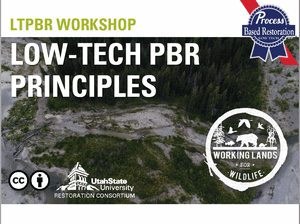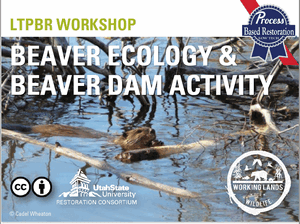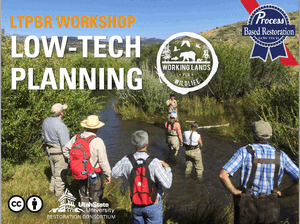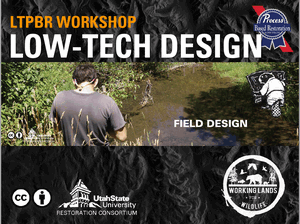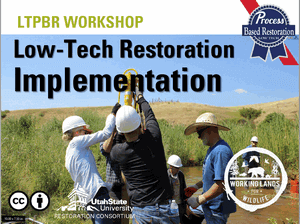Below you can find PDFs of the slides we covered in the intro to low-tech process-based restoration workshops for 2019. Each is licensed with a Creative Commons licence, so you are free to re-use subject to the terms of the license. NOTE: These were superseded in 2020 by the free virtual workshop materials:
Day 1 - Intro to Low-Tech Process Based Restoration
1. Logistics and Introductions
The workshop kicks off with some introductions and logistics.
2. Background and purpose
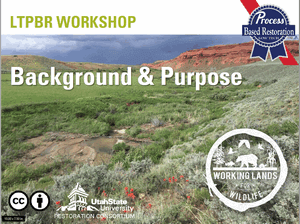 Next, we set the stage for why we’re here, underscore the scope of degradation, and lay out a vision for what is possible.
Next, we set the stage for why we’re here, underscore the scope of degradation, and lay out a vision for what is possible.
These talks are elaborated in Chapter 1 of design manual.
3. Build your first Beaver Dam Analogue exercise
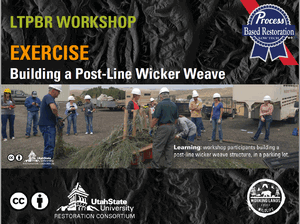 To break the ice, and get people thinking about construction, logistics and safety we went out in the parking lot to build a BDA. Participants follow a simple wicker weave recipe.
To break the ice, and get people thinking about construction, logistics and safety we went out in the parking lot to build a BDA. Participants follow a simple wicker weave recipe.
This exercise is elaborated in the Pocket Guide.
4. Introduction to low-tech approaches
 Having conquer the parking lot, we work through the diversity of low-tech approaches and structure types.
Having conquer the parking lot, we work through the diversity of low-tech approaches and structure types.
This talk is elaborated in Chapter 1 & Chapter 4 of design manual.
5. Guiding Principles
Perhaps the most important aspect to understand about low-tech process-based restoration: the underlying principles:
This talk is elaborated in Chapter 2 of design manual.
Day 2 - Planning and Designing Low-Tech Riparian Restoration
6. Beaver Ecology
In order to take advantage of beaver dam activity (one of the two key process we focus on in low-tech process-based restoration of structurally starved systems), we need to understand a bit about beaver ecology and why they build dams in the first place.
 This talk is elaborated in Ben Goldfarb’s new award winning book: Eager - The Surprising Secret Life of Beaver and Why they Matter.
This talk is elaborated in Ben Goldfarb’s new award winning book: Eager - The Surprising Secret Life of Beaver and Why they Matter.
7. Conservation Planning Process
We reframe the process of undertaking low-tech restoration within the NRCS’s Conservation Planning Process. Among the key adaptations of the Conservation Planning Process are learning how to read riverscapes.
- Introduction to Conservation Planning Process & Reading Riverscapes
- Riverscape Valley Setting Excercise - Handout
This talk is elaborated in Chapter 3 of design manual.
8. Planning in Detail
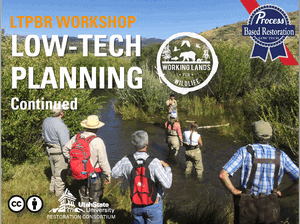 After returning from a field trip where we focused on reading riverscapes and identifying structurally-forced alterations to hydraulic and geomorphic processes, we worked through the planning phase of the CPP in detail with a series of desktop exercises.
After returning from a field trip where we focused on reading riverscapes and identifying structurally-forced alterations to hydraulic and geomorphic processes, we worked through the planning phase of the CPP in detail with a series of desktop exercises.
- Conservation Planning Process Intro - Slides
- Valley Bottom Mapping & Risks Assessment Exercise - Handout
This talk is elaborated in Chapter 3 of design manual.
Mimicking and promoting wood accumulation and beaver dam activity
We take a break from some of the exercises to focus on some of the science behind mimicking and promoting wood accumulation and beaver dam activity. Specifically, we focus on two Intensively Monitored Watershed Case Studies that have been the catalysts for low-tech process based restoration.
These talks are elaborated in Chapter 4 of design manual.
9. Case Study: Asotin Creek
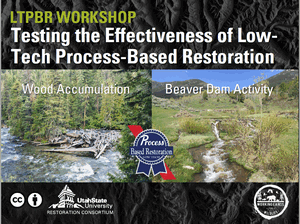 We introduce the idea of Intensively Monitored Watershed and shared insights and results from the Asotin Creek IMW in Washington about mimicking and promoting processes of wood accumulation:
We introduce the idea of Intensively Monitored Watershed and shared insights and results from the Asotin Creek IMW in Washington about mimicking and promoting processes of wood accumulation:
10. Case Study: Bridge Creek
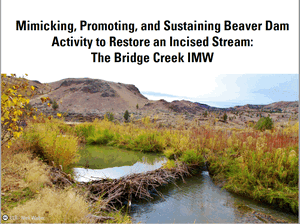 The Bridge Creek IMW in Oregon case study is used to show some of the underlying science behind mimicking and promoting processes of beaver dam activity:
The Bridge Creek IMW in Oregon case study is used to show some of the underlying science behind mimicking and promoting processes of beaver dam activity:
Extra Case Study Examples
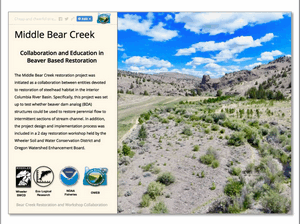 In some workshops, Nick Weber shares additional examples from Bear Creek and Parish Creek of some BDA projects:
In some workshops, Nick Weber shares additional examples from Bear Creek and Parish Creek of some BDA projects:
Please also see the resources pages, for more examples of case studies .
11. Design
We walk through the LT-PBR design process to prepare participants for doing their own designs in Day 3 in the field:
This talk is elaborated in Chapter 4 and Chapter 5 of design manual.
Example of Vision
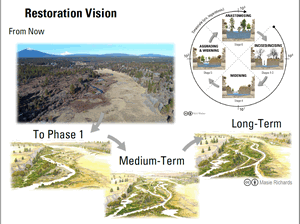 An example from Wychus Creek to elaborate on concepts covered in design talk and show examples of:
An example from Wychus Creek to elaborate on concepts covered in design talk and show examples of:
- Vision for Phased Implementation
- Simple Indicators for Monitoring
- Concept of Overlapping Complex Zones of Influence
12. Implementation
We covered implementation on Day 3 in the field, but here are some overview slides:
This is based mainly on Chapter 6 of the design manual.
A Rancher’s Story: Reintroducing beaver to bring back perennial flow
 Idaho rancher Jay Wilde shared his amazing story
Idaho rancher Jay Wilde shared his amazing story
- A Rancher’s Story: Reintroducing beaver to bring back perennial flow (Wilde et al. (2019)) If you missed it, see a version Jay gave last year here.
Day 3 - Building Low-Tech Restoration Structures
- Design Exercise - (Chapter 4 - Design Manual); Pocket Guide)
- Split into groups, discuss design objectives for their complex, layout project with flags Logistics, Safety & Post Pounding (Chapter 6 - Design Manual); Pocket Guide)
- Hands-on construction of various structures (PALS, Post-Assisted BDAs, Postless BDAs; Chapter 6 - Design Manual) - Design Manual; Pocket Guide)
- Review and critique constructed structures
- Discussions on adaptive management (Chapter 3, 4 & 6) - Design Manual)
- Workshop synthesis (review principles) & where to turn for help
References
- Silverman NL, Allred BW, Donnelly JP, Chapman TB, Maestas JD, Wheaton J, White J and Naugle DE. 2018. Low-tech riparian and wet meadow restoration increases vegetation productivity and resilience across semi-arid rangelands. Restoration Ecology. DOI: 10.1111/rec.12869.
- Weber N, Bouwes N, Pollock M, Volk C, Wheaton JM, Wathen G, and Jordan C. 2017. Alteration of stream temperature by natural and artificial beaver dams. PLOS ONE. 12(5): e0176313. DOI: 10.1371/journal.pone.0176313
- Wall E, Bouwes N, Wheaton JM, Bennett SN, Saunders WC, McHugh PA, and Jordan CE. 2016. Design and monitoring of woody structures and their benefits to juvenile steelhead trout (Oncorhynchus mykiss) using a net rate of energy intake model. Canadian Journal of Fisheries and Aquatic Sciences. DOI: 10.1139/cjfas-2016-0131.
- Bouwes N, Weber N, Jordan CE, Saunders WC, Tattam IA, Volk C, Wheaton JM and Pollock MM. 2016. Ecosystem experiment reveals benefits of natural and simulated beaver dams to a threatened population of steelhead (Oncorhynchus mykiss). Scientific Reports. 6: 28581. DOI: 10.1038/srep28581.
- Bouwes N, Bennett S and Wheaton JM. 2016. Adapting Adaptive Management for Testing the Effectiveness of Stream Restoration: An Intensively Monitored Watershed Example. Fisheries. 41: 2: pp. 84-91. DOI: 10.1080/03632415.2015.1127806
- Macfarlane WW‡ , Wheaton JM, Bouwes N, Jensen M, Hough-Snee N, and Shivick J. 2015. Modeling the capacity of riverscapes to support beaver dams. Geomorphology. DOI: 10.1016/j.geomorph.2015.11.019.
- Pollock, M., Beechie T , Wheaton JM, Jordan C, Bouwes N, Weber N, and Volk C. 2014. Using Beaver Dams to Restore Incised Stream Ecosystems. Bioscience. DOI: 10.1093/biosci/biu036.
- Wheaton J, Bennett S, Bouwes N, and Camp R. 2012. Asotin Creek Intensively Monitored Watershed: Restoration Plan for North Fork Asotin, South Fork Asotin and Charlie Creeks. Eco Logical Research, Inc., Prepared for Snake River Salmon Recovery Board. Logan, UT, 125 pp.
- Pollock M, Wheaton JM, Bouwes N and Jordan CE. 2012. Working with Beaver to Restore Salmon Habitat in the Bridge Creek Intensively Monitored Watershed: Design Rationale and Hypotheses. NOAA Technical Memorandum, NOAA Northwest Fisheries Science Center, Seattle, WA, 108 pp.

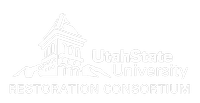
 FREE! LTPBR Workshop Modules and Self-Paced Resources
FREE! LTPBR Workshop Modules and Self-Paced Resources 
